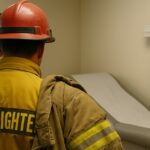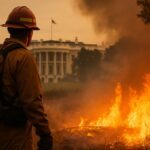Watching a hazy red sunset in the Northeast in July is a stark reminder that summer can bring more than just beach weather and summer holidays. The haze hanging over the horizon is the fallout of massive wildfires raging thousands of miles away in places like California and Arizona.
At the time of this writing, just one fire in California, the Dixie Fire, situated between Plumas and Butte counties, is burning over 85,000 acres of forest land.
And wildfires have consumed nearly half a million acres in the state of Arizona alone, a pace not seen since that state’s worst season in 2011, when over one million acres were burned.
Indeed, every year wildfires in America consume untold acreage and threaten countless communities and lives during the summer season.
Information provided by the Congressional Research Service highlights just how destructive these fires have been to affected areas:
“From 2011 to 2020, there were an average of 62,805 wildfires annually and an average of 7.5million acres impacted annually. In 2020, 58,950 wildfires burned 10.1 million acres, the second-most acreage impacted in a year (see Figure 2)since 1960; nearly 40% of these acres were in California.”
And our nation’s wildland firefighters are the ones tasked with tackling these mammoth blazes each and every year. But wildland firefighting comes with its own unique set of challenges and obstacles that have often led to hardship for those answering the call to fight these fires.

One of the biggest struggles that the wildland firefighting community has been taking on, is the massive pay and benefit gap that federal wildland firefighters are subjected to compared to their local counterparts.
In an op-ed in Grist, a veteran wildland firefighter points out that the massive bureaucracy of the federal government, who controls most the majority of land reserves in states like California which are most vulnerable during fire season, has allocated billions of dollars for wildfire funding, yet very little is paid to those doing the work:
“Wildland firefighters who work for one of these federal agencies share a common plight: the pay is low and the benefits are scarce. That makes it hard to retain people….
By some estimates, around 20 percent of permanent positions in federal firefighting went unfilled last year, and this can mean dangerously diminished efficacy on the fire line.”
The author goes on to point out that starting hourly pay for these workers can be as low $13/hour, leaving these firefighters to work hundreds of hours of overtime to make a livable wage for themselves and their families.
But like the author of the Grist piece, those who gear up to fight these fires are after more than just a paycheck.
Wildland firefighters in America and around the world are unified by the passion for their work, nature, and a sense of duty.
The unity of this profession is perhaps best captured by a video diary series by WildlandFirefighter.com, called The Wildfire Diaries, which takes submissions from around the world showcasing the experiences of wildland firefighters in different regions.
In Episode 1, viewers Santi Fuster, a firefighter with Spain’s GRAF service, who has been battling wildfires for two decades.
Santi recounts the lessons that he has learned, such as the need to analyze the behavior patterns of local fires, and the necessity of controlled burns to influence future containment.
Santi also recognizes a challenge which has inevitably become universal for wildland firefighters around the world.
Climate change combined with increased overgrowth in many forested areas has created tinder boxes around the globe which are burning bigger and longer than fires of past decades.
The series also introduces viewers to notable figures such as German wildfire activist, Louis Evert, who has fought blazes across Europe and even South Africa’s first all-female brigade, the Juliet Crew, who draw inspiration from America’s own Hot Shot firefighters.
The series is a great reminder that the struggles faced by wildland firefighters here in the United States are shared with many around the world working to protect their communities from these dangerous fires. But above all else, it is a reminder that wildland firefighters wherever they are found, are united by their passion, dedication, and desire to serve others, no matter how dangerous the job. This is why we launched our latest operations, to continue to build upon our mission to create change for the Fire and EMS communities, especially those out west fighting wildfires. For more on this operation, please visit https://firstresponderpoliticalaction.com/.
Departments and firefighters taking on massive blazes of wildfires need support and advocates to make sure their needs are met. And we are happy to announce that in California, we will be doing just that.








